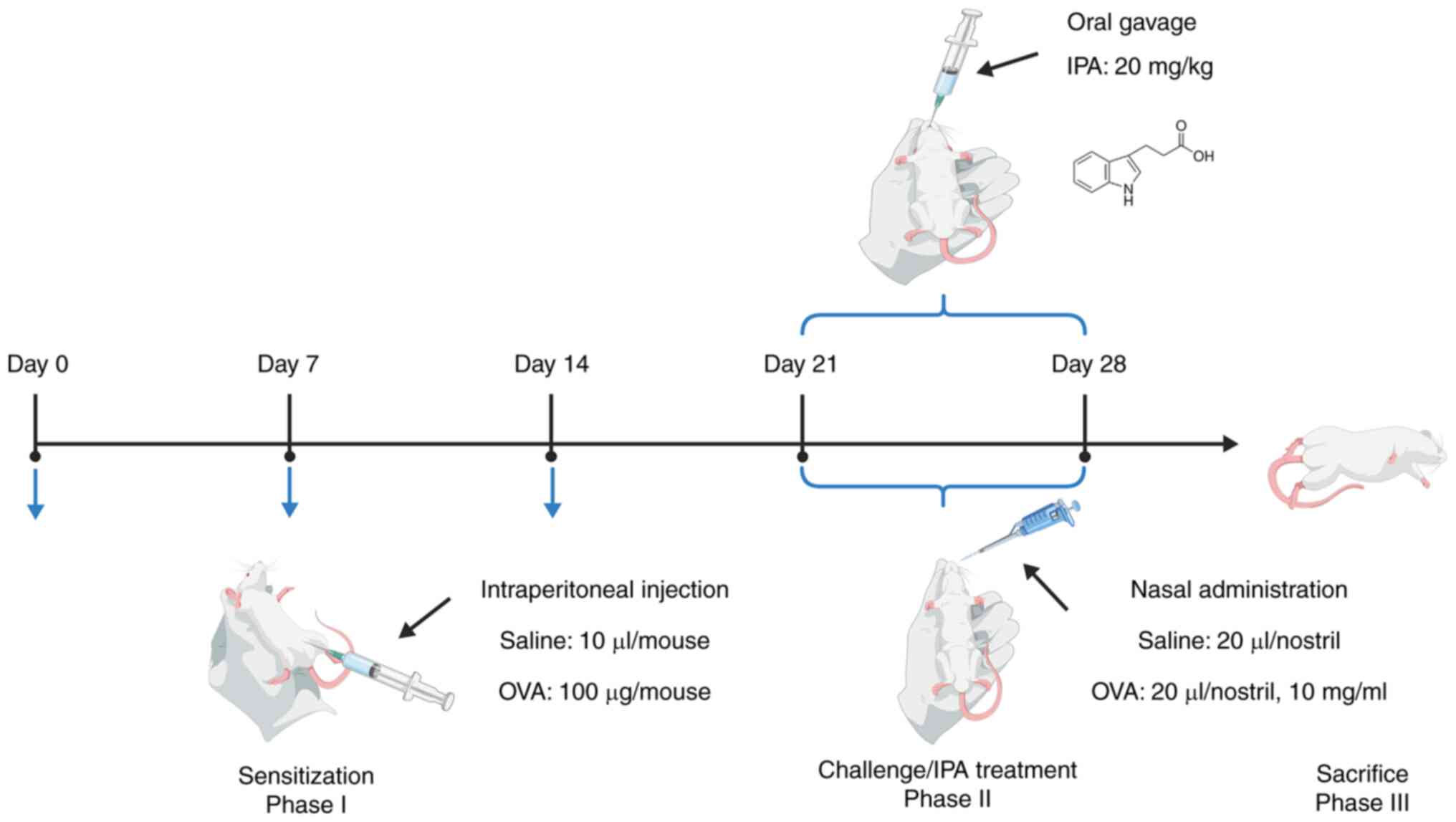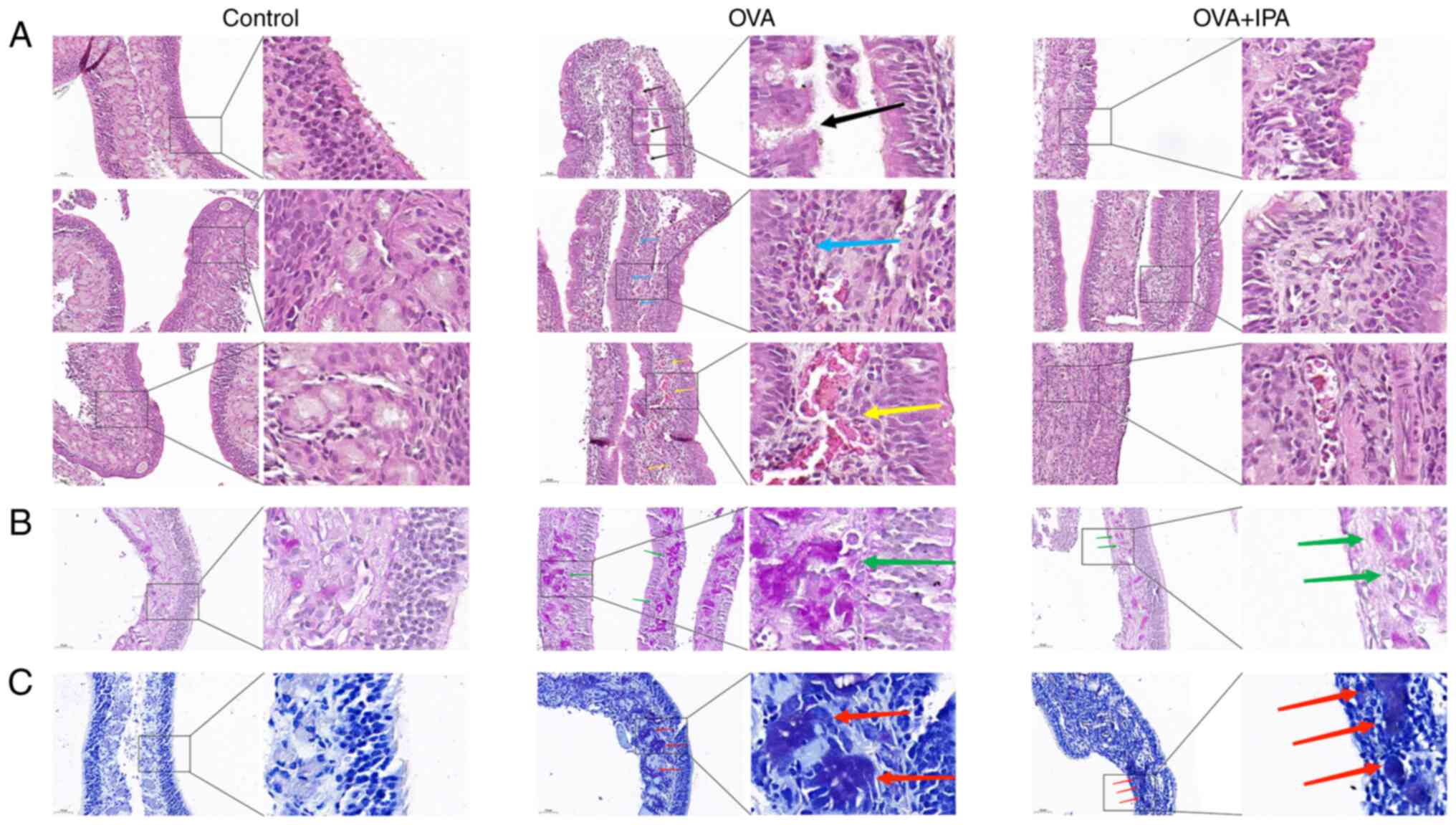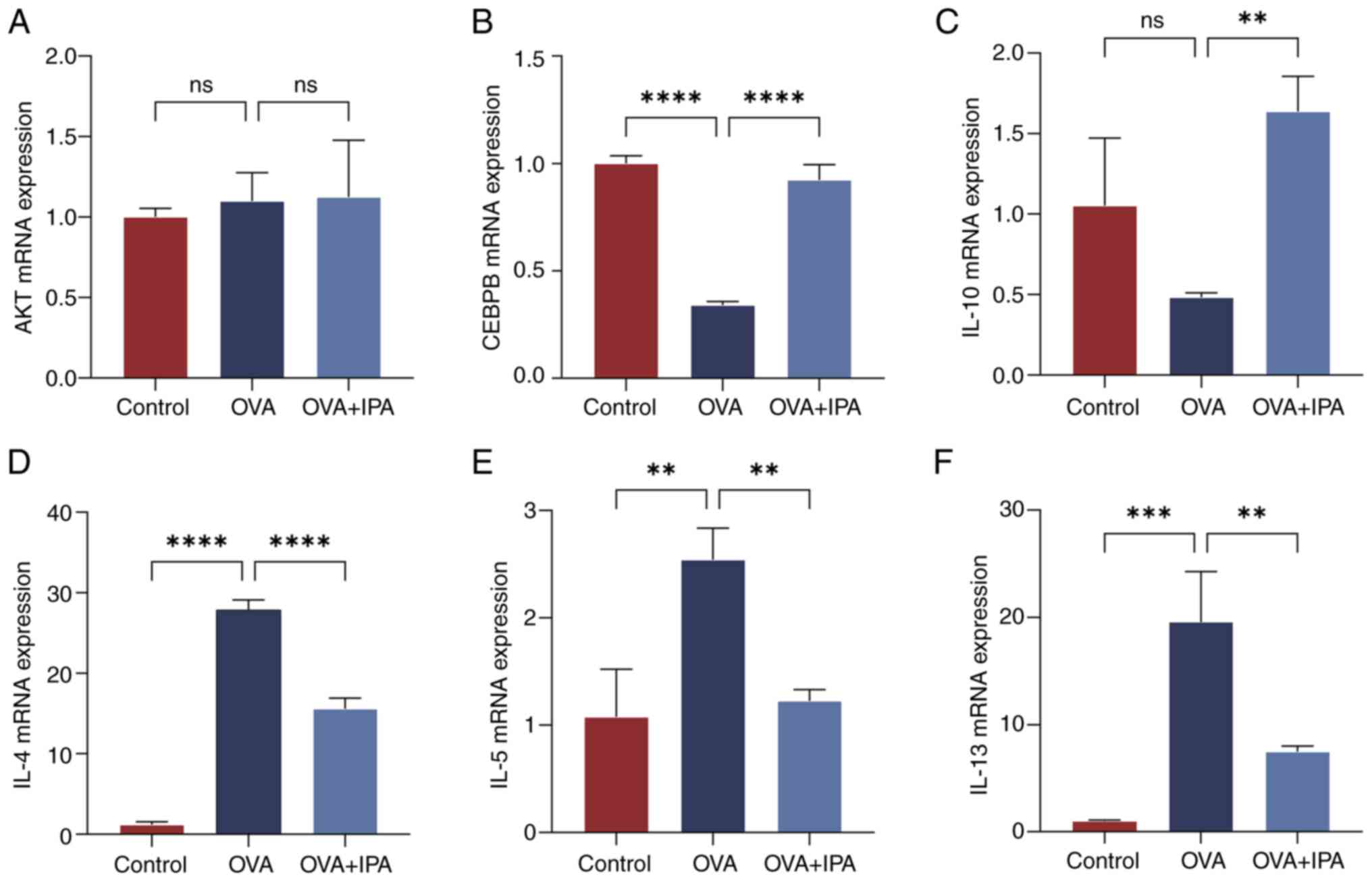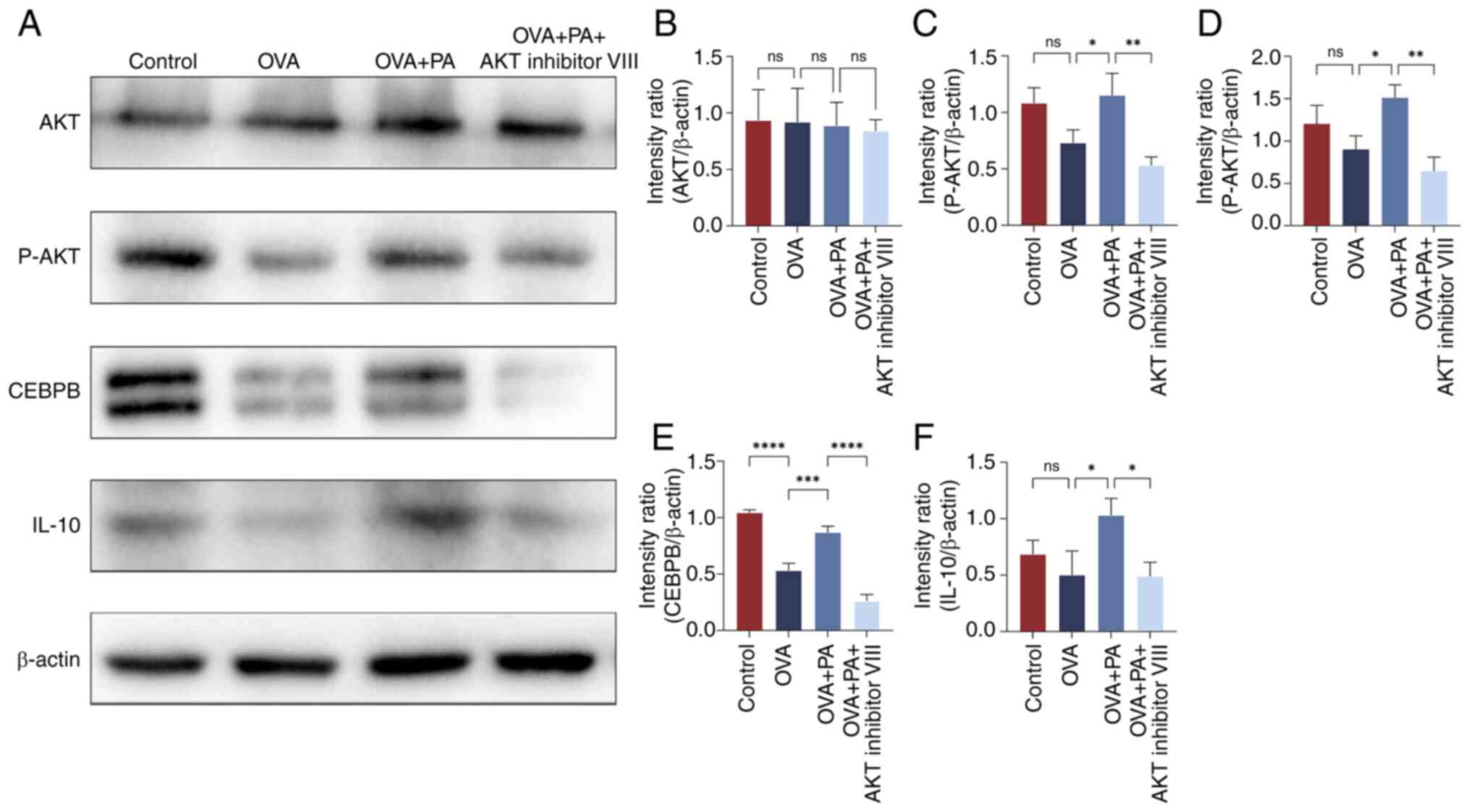|
1
|
Zhang Y, Lan F and Zhang L: Update on
pathomechanisms and treatments in allergic rhinitis. Allergy.
77:3309–3319. 2022. View Article : Google Scholar : PubMed/NCBI
|
|
2
|
Zhang Y, Lan F and Zhang L: Advances and
highlights in allergic rhinitis. Allergy. 76:3383–3389. 2021.
View Article : Google Scholar : PubMed/NCBI
|
|
3
|
Yang T, Wang HR, Mou YK, Liu WC, Wang Y,
Song XY, Ren C and Song XC: Mutual influence between allergic
rhinitis and sleep: Factors, mechanisms, and interventions-a
narrative review. Nat Sci Sleep. 16:1451–1467. 2024. View Article : Google Scholar : PubMed/NCBI
|
|
4
|
Mou YK, Wang HR, Zhang WB, Zhang Y, Ren C
and Song XC: Allergic rhinitis and depression: Profile and
proposal. Front Psychiatry. 12:8204972022. View Article : Google Scholar : PubMed/NCBI
|
|
5
|
Bousquet J, Schunemann HJ, Togias A,
Bachert C, Erhola M, Hellings PW, Klimek L, Pfaar O, Wallace D,
Ansotegui I, et al: Next-generation allergic rhinitis and its
impact on asthma (ARIA) guidelines for allergic rhinitis based on
grading of recommendations assessment, development and evaluation
(GRADE) and real-world evidence. J Allergy Clin Immunol.
145:70–80.e3. 2020. View Article : Google Scholar : PubMed/NCBI
|
|
6
|
Shamji MH, Sharif H, Layhadi JA, Zhu R,
Kishore U and Renz H: Diverse immune mechanisms of allergen
immunotherapy for allergic rhinitis with and without asthma. J
Allergy Clin Immunol. 149:791–801. 2022. View Article : Google Scholar : PubMed/NCBI
|
|
7
|
Kaczynska A, Klosinska M, Chmiel P,
Janeczek K and Emeryk A: The crosstalk between the gut microbiota
composition and the clinical course of allergic rhinitis: The Use
of probiotics, prebiotics and bacterial lysates in the treatment of
allergic rhinitis. Nutrients. 14:43282022. View Article : Google Scholar : PubMed/NCBI
|
|
8
|
Hu Y, Zhang R, Li J, Wang H, Wang M, Ren
Q, Fang Y and Tian L: Association between gut and nasal microbiota
and allergic rhinitis: A systematic review. J Asthma Allergy.
17:633–651. 2024. View Article : Google Scholar : PubMed/NCBI
|
|
9
|
Cheng HY, Chan J, Yap GC, Huang CH, Kioh
DYQ, Tham EH, Loo EXL, Shek LPC, Karnani N, Goh A, et al:
Evaluation of stool short chain fatty acids profiles in the first
year of life with childhood atopy-related outcomes. Front Allergy.
3:8731682022. View Article : Google Scholar : PubMed/NCBI
|
|
10
|
Konopelski P and Mogilnicka I: Biological
effects of indole-3-propionic acid, a gut microbiota-derived
metabolite, and its precursor tryptophan in mammals' health and
disease. Int J Mol Sci. 23:12222022. View Article : Google Scholar : PubMed/NCBI
|
|
11
|
Gao Y, Liu KY, Xiao W, Xie X, Liang Q, Tu
Z, Yang L, Yu H, Guo H, Huang S, et al: Aryl hydrocarbon receptor
confers protection against macrophage pyroptosis and intestinal
inflammation through regulating polyamine biosynthesis.
Theranostics. 14:4218–4239. 2024. View Article : Google Scholar : PubMed/NCBI
|
|
12
|
Zhuang H, Ren X, Jiang F and Zhou P:
Indole-3-propionic acid alleviates chondrocytes inflammation and
osteoarthritis via the AhR/NF-ĸB axis. Mol Med. 29:172023.
View Article : Google Scholar : PubMed/NCBI
|
|
13
|
Owumi SE, Najophe ES and Otunla MT:
3-Indolepropionic acid prevented chlorpyrifos-induced hepatorenal
toxicities in rats by improving anti-inflammatory, antioxidant, and
pro-apoptotic responses and abating DNA damage. Environ Sci Pollut
Res Int. 29:74377–74393. 2022. View Article : Google Scholar : PubMed/NCBI
|
|
14
|
Zhou CJ, Xie BL, Han HY, Wang Y, Wang YH,
Hong JY, Wei YX, Liu ZG, Feng Y, Yang G and Yang PC: Short-Chain
fatty acids promote immunotherapy by modulating immune regulatory
property in B cells. J Immunol Res. 2021:26843612021. View Article : Google Scholar : PubMed/NCBI
|
|
15
|
Manning BD and Toker A: AKT/PKB signaling:
Navigating the network. Cell. 169:381–405. 2017. View Article : Google Scholar : PubMed/NCBI
|
|
16
|
Martin LJ and Nguyen HT: Basic leucine
zipper transcription factors as important regulators of leydig
cells' functions. Int J Mol Sci. 23:128872022. View Article : Google Scholar : PubMed/NCBI
|
|
17
|
Ramji DP and Foka P:
CCAAT/enhancer-binding proteins: Structure, function and
regulation. Biochem J. 365:561–575. 2002. View Article : Google Scholar : PubMed/NCBI
|
|
18
|
Hernandez-Encinas E, Aguilar-Morante D,
Cortes-Canteli M, Morales-Garcia JA, Gine E, Santos A and
Perez-Castillo A: CCAAT/enhancer binding protein β directly
regulates the expression of the complement component 3 gene in
neural cells: Implications for the pro-inflammatory effects of this
transcription factor. J Neuroinflammation. 12:142015. View Article : Google Scholar : PubMed/NCBI
|
|
19
|
Cao Y, Fan M, Pei Y, Su L, Xiao W, Chen F,
Huang J, Liu X, Gu Z, Zhang Z, et al: CCAAT/enhancer-binding
protein homologous protein (CHOP) deficiency attenuates
heatstroke-induced intestinal injury. Inflammation. 45:695–711.
2022. View Article : Google Scholar : PubMed/NCBI
|
|
20
|
Niehrs C and Calkhoven CF: Emerging Role
of C/EBPβ and epigenetic DNA methylation in ageing. Trends Genet.
36:71–80. 2020. View Article : Google Scholar : PubMed/NCBI
|
|
21
|
Greene LA, Zhou Q, Siegelin MD and
Angelastro JM: Targeting transcription factors ATF5, CEBPB and
CEBPD with cell-penetrating peptides to treat brain and other
cancers. Cells. 12:5812023. View Article : Google Scholar : PubMed/NCBI
|
|
22
|
Larabee JL, Hauck G and Ballard JD:
Unique, intersecting, and overlapping roles of C/EBP β and CREB in
cells of the innate immune system. Sci Rep. 8:169312018. View Article : Google Scholar : PubMed/NCBI
|
|
23
|
Liu YW, Tseng HP, Chen LC, Chen BK and
Chang WC: Functional cooperation of simian virus 40 promoter factor
1 and CCAAT/enhancer-binding protein beta and delta in
lipopolysaccharide-induced gene activation of IL-10 in mouse
macrophages. J Immunol. 171:821–828. 2003. View Article : Google Scholar : PubMed/NCBI
|
|
24
|
Selter F, Hetzel T, Kahrass H and Mertz M:
Animal research ethics as interaction of research ethics, animal
ethics, and (animal protection) law. ALTEX. 40:541–544.
2023.PubMed/NCBI
|
|
25
|
Shi Z, Jiang W, Chen X, Xu M, Wang J, Lai
Y and Zha D: Chlorogenic acid ameliorated allergic rhinitis-related
symptoms in mice by regulating Th17 cells. Biosci Rep.
40:BSR202016432020. View Article : Google Scholar : PubMed/NCBI
|
|
26
|
Bui TT, Kwon DA, Choi DW, Jung SY, Lee SY,
Piao CH, Hyeon E, Fan Y, Yeon SH, Son RH, et al: Rosae multiflorae
fructus extract and its four active components alleviate
ovalbumin-induced allergic inflammatory responses via regulation of
Th1/Th2 imbalance in BALB/c rhinitis mice. Phytomedicine.
55:238–248. 2019. View Article : Google Scholar : PubMed/NCBI
|
|
27
|
Zhang J, Gao L, Yu D, Song Y, Zhao Y and
Feng Y: Three Artemisia pollens trigger the onset of allergic
rhinitis via TLR4/MyD88 signaling pathway. Mol Biol Rep.
51:3192024. View Article : Google Scholar : PubMed/NCBI
|
|
28
|
Livak KJ and Schmittgen TD: Analysis of
relative gene expression data using real-time quantitative PCR and
the 2(−Delta Delta C(T)) Method. Methods. 25:402–408. 2001.
View Article : Google Scholar : PubMed/NCBI
|
|
29
|
Wise SK, Damask C, Roland LT, Ebert C,
Levy JM, Lin S, Luong A, Rodriguez K, Sedaghat AR, Toskala E, et
al: International consensus statement on allergy and rhinology:
Allergic rhinitis- 2023. Int Forum Allergy Rhinol. 13:293–859.
2023. View Article : Google Scholar : PubMed/NCBI
|
|
30
|
Goetzl EJ: Th2 cells in rapid immune
responses and protective avoidance reactions. FASEB J.
38:e234852024. View Article : Google Scholar : PubMed/NCBI
|
|
31
|
Casaro M, Souza VR, Oliveira FA and
Ferreira CM: OVA-induced allergic airway inflammation mouse model.
Methods Mol Biol. 1916:297–301. 2019. View Article : Google Scholar : PubMed/NCBI
|
|
32
|
Xiao H, Tang AZ, Xu ML, Chen HL, Wang F
and Li CQ: Mycobacterium vaccae attenuates airway inflammation by
inhibiting autophagy and activating PI3K/Akt signaling pathway in
OVA-induced allergic airway inflammation mouse model. Mol Immunol.
173:30–39. 2024. View Article : Google Scholar : PubMed/NCBI
|
|
33
|
Tan JK, Macia L and Mackay CR: Dietary
fiber and SCFAs in the regulation of mucosal immunity. J Allergy
Clin Immunol. 151:361–370. 2023. View Article : Google Scholar : PubMed/NCBI
|
|
34
|
Li L, Yang C, Jia M, Wang Y, Zhao Y, Li Q,
Gong J, He Y, Xu K, Liu X, et al: Synbiotic therapy with
Clostridium sporogenes and xylan promotes gut-derived
indole-3-propionic acid and improves cognitive impairments in an
Alzheimer's disease mouse model. Food Funct. 15:7865–7882. 2024.
View Article : Google Scholar : PubMed/NCBI
|
|
35
|
Xu H, Luo Y, An Y and Wu X: The mechanism
of action of indole-3-propionic acid on bone metabolism. Food
Funct. 16:406–421. 2025. View Article : Google Scholar : PubMed/NCBI
|
|
36
|
Yang C, Du Y, Li Q, Liu L, Zhao L, Gao C,
Tang Z, Zhang X, Zhao Y and Yang X: Fructo-oligosaccharides
alleviated ulcerative colitis via gut microbiota-dependent
tryptophan metabolism in association with aromatic hydrocarbon
receptor activation in mice. J Agric Food Chem. 72:27912–27922.
2024. View Article : Google Scholar : PubMed/NCBI
|
|
37
|
Wang A, Guan C, Wang T, Mu G and Tuo Y:
Lactobacillus-derived indole derivatives ameliorate intestinal
barrier damage in rat pups with complementary food administration.
Food Funct. 15:8775–8787. 2024. View Article : Google Scholar : PubMed/NCBI
|
|
38
|
Chen Y, Li Y, Li X, Fang Q, Li F, Chen S
and Chen W: Indole-3-propionic acid alleviates intestinal
epithelial cell injury via regulation of the TLR4/NF-ĸB pathway to
improve intestinal barrier function. Mol Med Rep. 30:1892024.
View Article : Google Scholar : PubMed/NCBI
|
|
39
|
Li G, Lin J, Zhang C, Gao H, Lu H, Gao X,
Zhu R, Li Z, Li M and Liu Z: Microbiota metabolite butyrate
constrains neutrophil functions and ameliorates mucosal
inflammation in inflammatory bowel disease. Gut Microbes.
13:19682572021. View Article : Google Scholar : PubMed/NCBI
|
|
40
|
Hezaveh K, Shinde RS, Klotgen A, Halaby
MJ, Lamorte S, Ciudad MT, Quevedo R, Neufeld L, Liu ZQ, Jin R, et
al: Tryptophan-derived microbial metabolites activate the aryl
hydrocarbon receptor in tumor-associated macrophages to suppress
anti-tumor immunity. Immunity. 55:324–340. e82022. View Article : Google Scholar : PubMed/NCBI
|
|
41
|
York AG, Skadow MH, Oh J, Qu R, Zhou QD,
Hsieh WY, Mowel WK, Brewer JR, Kaffe E, Williams KJ, et al: IL-10
constrains sphingolipid metabolism to limit inflammation. Nature.
627:628–635. 2024. View Article : Google Scholar : PubMed/NCBI
|
|
42
|
Fan K, Jin L and Yu S: Roles of regulatory
B cells in the pathogenesis of allergic rhinitis. Allergol
Immunopathol (Madr). 50:7–15. 2022. View Article : Google Scholar : PubMed/NCBI
|
|
43
|
Fang D and Zhu J: Molecular switches for
regulating the differentiation of inflammatory and IL-10-producing
anti-inflammatory T-helper cells. Cell Mol Life Sci. 77:289–303.
2020. View Article : Google Scholar : PubMed/NCBI
|
|
44
|
Coomes SM, Kannan Y, Pelly VS, Entwistle
LJ, Guidi R, Perez-Lloret J, Nikolov N, Müller W and Wilson MS:
CD4(+) Th2 cells are directly regulated by IL-10 during allergic
airway inflammation. Mucosal Immunol. 10:150–161. 2017. View Article : Google Scholar : PubMed/NCBI
|
|
45
|
Mitchell RE, Hassan M, Burton BR, Britton
G, Hill EV, Verhagen J and Wraith DC: IL-4 enhances IL-10
production in Th1 cells: Implications for Th1 and Th2 regulation.
Sci Rep. 7:113152017. View Article : Google Scholar : PubMed/NCBI
|
|
46
|
Caucheteux SM, Hu-Li J, Guo L,
Bhattacharyya N, Crank M, Collins MT and Paul WE: IL-1β enhances
inflammatory TH2 differentiation. J Allergy Clin Immunol.
138:898–901.e4. 2016. View Article : Google Scholar : PubMed/NCBI
|
|
47
|
van der Krieken SE, Popeijus HE, Mensink
RP and Plat J: CCAAT/enhancer binding protein β in relation to ER
stress, inflammation, and metabolic disturbances. Biomed Res Int.
2015:3248152015. View Article : Google Scholar : PubMed/NCBI
|
|
48
|
Zhou J, Li H, Xia X, Herrera A, Pollock N,
Reebye V, Sodergren MH, Dorman S, Littman BH, Doogan D, et al:
Anti-inflammatory activity of MTL-CEBPA, a small activating RNA
drug, in LPS-stimulated monocytes and humanized mice. Mol Ther.
27:999–1016. 2019. View Article : Google Scholar : PubMed/NCBI
|
|
49
|
Collins CB, Puthoor PR, Nguyen TT,
Strassheim D, Jedlicka P, Friedman JE and de Zoeten EF: C/EBPβ
deletion promotes expansion of poorly functional intestinal
regulatory T cells. J Crohns Colitis. 12:1475–1485. 2018.
View Article : Google Scholar : PubMed/NCBI
|
|
50
|
Liu Q, Peng Z, Zhou L, Peng R, Li X, Zuo
W, Gou J, Zhou F, Yu S, Huang M and Liu H: Short-chain fatty acid
decreases the expression of CEBPB to inhibit mir-145-mediated DUSP6
and thus further suppresses intestinal inflammation. Inflammation.
45:372–386. 2022. View Article : Google Scholar : PubMed/NCBI
|
|
51
|
Weichhart T, Hengstschlager M and Linke M:
Regulation of innate immune cell function by mTOR. Nat Rev Immunol.
15:599–614. 2015. View Article : Google Scholar : PubMed/NCBI
|
|
52
|
Xu J, Ye Y, Ji J, Sun J, Wang JS and Sun
X: Untargeted metabolomic profiling reveals changes in gut
microbiota and mechanisms of its regulation of allergy in
OVA-Sensitive BALB/c mice. J Agric Food Chem. 70:3344–3356. 2022.
View Article : Google Scholar : PubMed/NCBI
|
|
53
|
Tang Y, She Y, Chen D, Zhou Y, Xie D and
Liu Z: 16S rRNA sequencing-based evaluation of the protective
effects of key gut microbiota on inhaled allergen-induced allergic
rhinitis. Front Microbiol. 15:14972622024. View Article : Google Scholar : PubMed/NCBI
|























